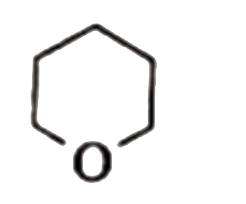The 'X' in the given reaction ?
CH2OH∣CH2OH+oxalic acid 210∘C−−−→X(major product)
CH2∣∣CH2
CH−OH∣∣CH2
CHO∣CHO
CH2OH∣CHO
The correct Answer is:A
To solve the problem of determining the product 'X' when ethylene glycol reacts with oxalic acid at 210°C, we will follow these steps:
Step 1: Identify the Reactants
The reactants are ethylene glycol (HOCH2CH2OH) and oxalic acid (HOOC-COOH). Ethylene glycol can be represented as CH2OH (for each hydroxymethyl group), and oxalic acid has the structure of two carboxylic acid groups connected by a carbon chain.
Step 2: Understand the Reaction Type
The reaction between an alcohol (ethylene glycol) and a carboxylic acid (oxalic acid) typically leads to esterification. In this case, since we have a diol (ethylene glycol) and a dicarboxylic acid (oxalic acid), we can expect the formation of a cyclic ester (a lactone) through intramolecular esterification.
Step 3: Draw the Structures
1. Ethylene Glycol:
- CH2OH - CH2OH
2. Oxalic Acid:
- HOOC - COOH
Step 4: Mechanism of Reaction
1. The hydroxyl group of ethylene glycol will attack the carbonyl carbon of one of the carboxylic groups of oxalic acid.
2. This will lead to the formation of a tetrahedral intermediate.
3. An intramolecular proton transfer will occur, leading to the departure of water and the formation of a cyclic structure.
4. The remaining hydroxyl group will then attack the other carbonyl carbon, leading to a second intramolecular proton transfer and the formation of a cyclic ester.
Step 5: Final Product
The final product 'X' will be a cyclic compound formed by the reaction of ethylene glycol and oxalic acid. The structure will resemble a five-membered ring with two carbonyl groups and an ether linkage.
Conclusion
The major product 'X' formed from the reaction of ethylene glycol and oxalic acid at 210°C is a cyclic ester, specifically a lactone.
---
The reactants are ethylene glycol (HOCH2CH2OH) and oxalic acid (HOOC-COOH). Ethylene glycol can be represented as CH2OH (for each hydroxymethyl group), and oxalic acid has the structure of two carboxylic acid groups connected by a carbon chain.
The reaction between an alcohol (ethylene glycol) and a carboxylic acid (oxalic acid) typically leads to esterification. In this case, since we have a diol (ethylene glycol) and a dicarboxylic acid (oxalic acid), we can expect the formation of a cyclic ester (a lactone) through intramolecular esterification.
1. Ethylene Glycol:
- CH2OH - CH2OH
2. Oxalic Acid:
- HOOC - COOH
1. The hydroxyl group of ethylene glycol will attack the carbonyl carbon of one of the carboxylic groups of oxalic acid.
2. This will lead to the formation of a tetrahedral intermediate.
3. An intramolecular proton transfer will occur, leading to the departure of water and the formation of a cyclic structure.
4. The remaining hydroxyl group will then attack the other carbonyl carbon, leading to a second intramolecular proton transfer and the formation of a cyclic ester.
The final product 'X' will be a cyclic compound formed by the reaction of ethylene glycol and oxalic acid. The structure will resemble a five-membered ring with two carbonyl groups and an ether linkage.
The major product 'X' formed from the reaction of ethylene glycol and oxalic acid at 210°C is a cyclic ester, specifically a lactone.
Topper's Solved these Questions
- JEE MAIN 2021BOOK - JEE MAINS PREVIOUS YEARCHAPTER - JEE MAIN 2021EXERCISE - SECTION-B
50 Videos
- JEE MAIN 2021BOOK - JEE MAINS PREVIOUS YEARCHAPTER - JEE MAIN 2021EXERCISE - CHEMISTRY (SECTION-A)
20 Videos
- JEE MAIN 2021BOOK - JEE MAINS PREVIOUS YEARCHAPTER - JEE MAIN 2021EXERCISE - Chemistry (Section B)
10 Videos
- JEE MAINBOOK - JEE MAINS PREVIOUS YEARCHAPTER - JEE MAINEXERCISE - CHEMISTRY
150 Videos
- JEE MAIN 2022BOOK - JEE MAINS PREVIOUS YEARCHAPTER - JEE MAIN 2022EXERCISE - Question
561 Videos
Similar Questions
Knowledge Check
In the sequence of the following reactions
CH3CH2OH[0]−−−−−−−→Chromic AcidX
X[0]−−−−−−−→Chromic acidCH3COOH , here x isACH3COCH3BCH3CHOCCH3OCH3DCH3CH2COOHIn the reaction CH2OH∣CHOH∣CH2OH+COOH∣COOH110∘C−−−→(A), product (A) will be __________.
Aglycerol monoformateBallyl alcoholCformaldehydeDacetic acidIn the given reaction
Br∣CH2−(CH2)3−CH2OHNaOH−−−−−−−−−→Toluene140∘C(X)
'X' will beAOH∣CH2−(CH2)4−CH2OHBCH2=CH−(CH2)3−CH2OHCCH3−OH∣CH−(CH2)3−CH2OHD
In the following sequence of reaction, the major product ( C)
CH3CH2INaCN−−−→(A)OH−−−−−−−−−−→Partial hydrolysis(B)Br2/NaOH−−−−−−→(C)
View SolutionConsider the given reaction and identify the product P
CH3−CH=CH−CH2−OHHBr−−→SN1P
View SolutionConsider the given reaction and identify the product P
CH3−CH=CH−CH2−OHHBr−−→SN1P
View SolutionThe major product formed in the following reaction
CH3CH(Cl)CH2−CH2OHaq.KOH−−−−→
View SolutionThe major product formed in the reaction is:
CH3−CH3∣C∣H−CH2BrCH3OӨ−−−−→CH3OH
View Solution
